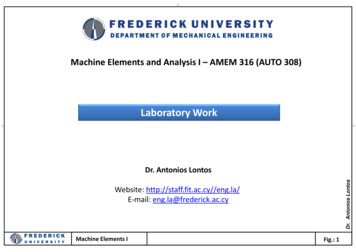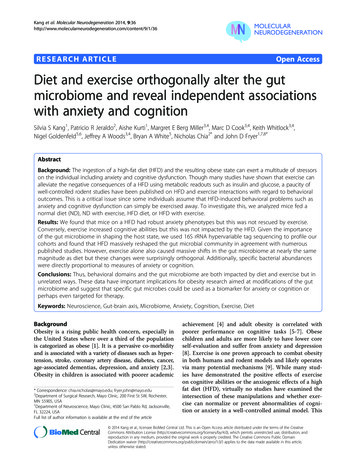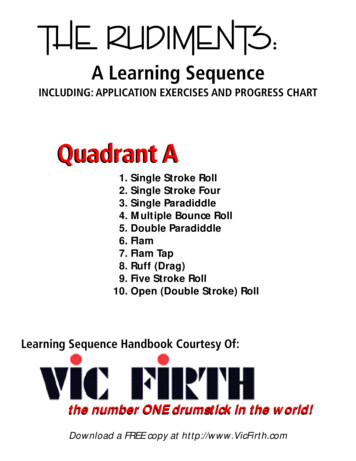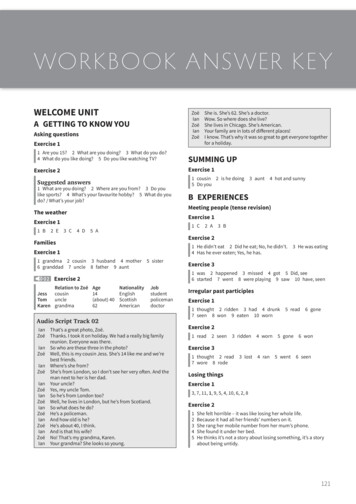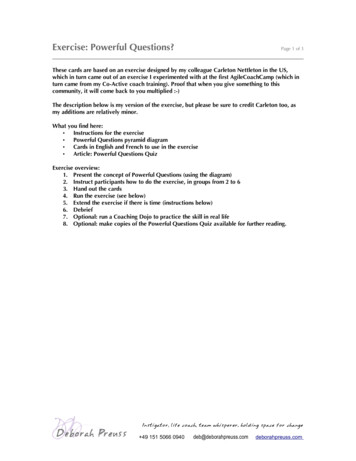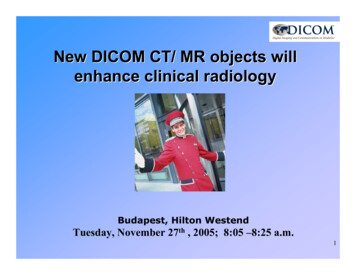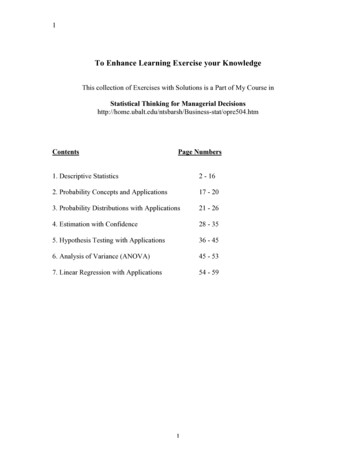
Transcription
1To Enhance Learning Exercise your KnowledgeThis collection of Exercises with Solutions is a Part of My Course inStatistical Thinking for Managerial tat/opre504.htmContentsPage Numbers1. Descriptive Statistics2 - 162. Probability Concepts and Applications17 - 203. Probability Distributions with Applications21 - 264. Estimation with Confidence28 - 355. Hypothesis Testing with Applications36 - 456. Analysis of Variance (ANOVA)45 - 537. Linear Regression with Applications54 - 591
21. Descriptive Statistics1.1: Complete the following table:Grade on BusinessStatistics ExamFrequencyRelative FrequencyA: 90-10016.08B: 80-89C: 65-79D: 50-64F: below 5036903028TOTAL1.00SolutionComplete the following table:Grades on BusinessStatistics ExamA: 90-100B: 80-89C: 65-79D: 50-64F: Below 50TOTALFrequencyRelative Frequency1636903028200.08.18.45.15.141.00For B: 80-89: 36 / 200 .181.2: The Journal of Consumer Marketing reported on a study of company response toletters of consumer complaints. Marketing students at a large Midwest public university“were asked to write letters of compliant to companies whose products legitimatelycaused them to be dissatisfied”. Of the 750 students in the class, 286 wrote letters ofcomplaint. The table shows the type of response received from the companies andnumber of each type.2
3Type of ResponseNumberLetter and product replacementLetter and good couponLetter and cents-off couponLetter and refund checkLetter, refund check and couponLetter onlyNo response42362923137667TOTAL286a. Display the study results in a relative frequency bar graph.b. What percentage of consumers received a response to their letter of complaint?SolutionType of ResponseNumber1-Letter and product replacement2-Letter and good coupon3-Letter and cents-off coupon4-Letter and refund check5-Letter, refund check and coupon6-Letter only7-No 47.126.101.08.042.266.2341.00
4b) Percentage of customers received a response to their letter of complaint?286 – 67 219219 / 286 * 100 76.57%Notice: The histogram is not unimodal, having more than one modes, indication thepopulation is a mixture of two or more sub-populations.Therefore performing any statistical analysis is meaningless. One must separate the subpopulations to be able to do any analyses on each one of them separately.1.3: A sample of 20 measurements is shown here:2622341221563239422536412830382317273919a. Using the first digit as a stem, list the stem possibilities in order.b. Place the leaf for each observation in the appropriate stem row to form a stemand-leaf display.Solutiona) using the first digit, the stem possibilities are: 1, 2, 3, 4 and 5b) stem-and-leaf display:StemsLeaves123452, 7, 91, 2, 3, 5, 6, 7, 80, 2, 4, 6, 8, 9, 91, 261.4: A sample of 20 measurements is shown here:2622341221263239322536312830382317273919a. Using a class interval width of 5, give the upper and lower boundaries for sixclass intervals, where the lower boundary of the first class is 10.5.b. Determine the relative frequency for each of the six classes specific in part a.c. Construct a relative frequency histogram using the results of part b.4
5SolutionA sample of 20 measurements is shown here:2622Class12345634122126Class Interval10.5 – 15.515.5 – 20.520.5 – 25.525.5 – 30.530.5 – 35.535.5 – 40.5Total323932253631Class Frequency1245442028303823a.b.53919Class Relative Frequency.05.1.2.25.2.21.001.5: Suppose a data set contains the observations 3, 8, 4, 5, 3, 4, 6. Find:a. xb. x²c. (x-5) ²d. (x-2) ²e. ( x) ²Solution1727
6c.d.e.1.6: Find the mean and the median for the following sample of n 6 measurements: 7, 3, 4, 1,5, 6Solution1.7: Find the range, variance, and standard deviation for the following data set:39074Use the shortcut procedure to calculate s².SolutionSet: 3, 9, 0, 7, 4Range 9 – 0 9Variance s2 [ x2 - ( x)2 /n] / n – 1 x2 - n(xbar)2 / n – 1 [155 – 4.6] / 4 37.6Standard Deviation square root [ (x – xbar)2 / n – 1] sr [5.76 19.36 21.16 5.76 0.36] / 4 sr(52.4 / 4) sr(13.1) 3.621.8: Compute z scores for each of the following situations. Then determine which xvalues lies the greatest distance above the mean; the greatest distance below the mean.a. x 77, x 58, s 8b. x 8.8, x 11, s 26
7c. x 0, x -5, s 1.5d. x 2.9, x 3, s .1Solutionx778.802.9Mean(x)sz score5811-53821.50.12.375-1.1003.333-1.000From the values of Z Score it is clear that the value 0 lies the greatest distance above themean, and the value 8.8 lies the greatest distance below the mean.1.9: One way in which stock market analysts measure the price volatility of an individualstock relative to the market is to compute the stock’s beta value. Beta values greater than1 indicate that the stock’s price has changed slower than the average market pricewhereas bet values less than 1 indicate that the stock price has changed slower than theaverage market price. The accompanying table lists the ticker abbreviations and betavalues for a recent sample of 25 Standard & Poor’s 500 stocks.7
01.304a. Calculate x, s², and s for 25 beta values. How many beta values lie within interval x 2s? Does this result agree with the Empirical rule?b. Calculate the median. Interpret this value.c. Find the 80th percentile of the 25 beta values.d. The ticker abbreviation S represents Sears & Roebuck stock. Find the z score of thebeta value for Sears & Roebuck. Interpret the value.8
9SolutionTicker Beta (x) 960ZE1.3041.700Total26.81334.165a. x 26.813 x2 26.813( x)2 718.94Mean xbar 1.073Variance, s2 0.225313Standard deviation, s 0.474671Range : xbar - 2s 0.123178, andxbar 2s 2.021862All 25 values lies between these ranges.The Empirical rule states that close to 95% of observations will lie in this range forsymmetric distributions, it also states that the percentage will be near 100% for highlyskewed distributions.In this case because all 25 values lie in this range we can say that the values aresymmetric and highly skewed.9
10b.Sorting the 25 numbers in ascending order we can see that the 13th number. 0.987, is themedian.This means that of the remaining 24 numbers, 50%, or 12 numbers are smaller than thisnumber and the other 12 numbers are greater than the 1.4891.5021.6621.7311.7362.01410
11c.The 80th percentile 80 x (25 1)/100 21Therefore the 21st number, 1.502, is in the 80th percentile.d.Z Score of S (x - xbar)/s (0.688 - 1.073)/ 0.474671 -0.81008The negative sign in the z score means that the observation lies to the left of the mean,because the absolute value.More Detailed Solution: One way in which stock market analysts measure the pricevolatility of an individual stock relative to the market is to compute the stock’s betavalue. Beta values greater than 1 indicates that the stock’s price has changed faster thanthe average market price, whereas beta values less than 1 indicate that the stock’s pricechanged slower than the average market price. The accompanying table lists the tickerabbreviations and beta values for a recent sample of 25 Standard & Satellite?pagename sp/Page/HomePg&r 1&l EN 500 stocks.11
12Note: Table arranged in ascending ZEVOPRDALLITMATWENHIANSMTotalBeta 144.0634.165(A):(a) Mean Xbar is the sum of all betas divided by n (which is 25) x 26.793; n 25; xbar x / n 1.071(b) Variance is s2 SS/ (n-1), where SS SS deviations [ x2 – ( x) 2 /n ] ,Given x 28.714. and x2 34.165; thusSS deviations [ x2 – ( x) 2/n ] [(34.165) – (28.714)],Therefore,Variance s2 SS/ (n-1) [(34.165) – (28.714)] / 24 0.22712512
13(c) Standard Deviation is s s2 (0.227125) 0.4765(d) xbar 2 s 2.024 ; xbar – 2s 0.118;At least 95% of observation values lie within this range of 0.118 and 2.024. Thisconforms to the Empirical Rule which states that at least 95 % of the number ofobservations will lie within the range of x (bar) 1.96s.All betas are within the interval. The Empirical Rule posits close to 95% of observationsfalling within the xbar 1.96s interval for symmetric distributions, while the percentagewill be larger (near 100%) for highly skewed distributions. Since 100% of the betas inthe sample fall within the Xbar 1.96s interval, the density distribution function isskewed.Ordered Statistics and Construction of 40.680.720.760.800.840.880.920.96113
14(B):Median is the 13th number as there are odd numbers of observations. Hence median is0.987. Notice that, the median value is .987 and the mean is 1.073. The data set isskewed to the right(C):pth percentile p(n 1) / 100;Hence the 80th percentile 80(25 1) / 100 20.8 which is approximated to the 21stnumber which is 1.502.(D):z {x – xbar) / s (0.668 – 1.071) / 0.4765 - 0.8458A negative z – score indicates that the observation lies to the left of the mean.Because the data set is skewed, the Z score needs to be less than 1 for this value not to bean outlier. Therefore the beta of Sears & Roebuck is most likely not an outlier.14
1515
16Notice: The histogram is not unimodal, having more than one modes, indication thepopulation is a mixture of two or more sub-populations.Therefore performing any statistical analysis is meaningless. One must separate the subpopulations to be able to do any analyses on each one of them separately.- Other applications of Z-Scores16
172. Probability Concepts and Applications2.1: In New York City, the leading cause of death on the job is not constructionaccidents, machinery malfunctions, or car crashes – it is homicide! A federal Bureau oflabor Statistics study revealed that of 177 New York City workers who died of injuriessustained on the job last year,122 were homicide victims. Use this information toestimate the probability that an on-the-job death of a New York City worker is the resultof a homicide.SolutionThe probability that an on-the-job death of a New York City worker is the result of ahomicide is:2.2: An experiment has 5 possible outcomes (simple events) with the followingprobabilities:Simple EventProbabilityS1S2S3S4S5.15.20.20.25.20a. Find the probability of each of the following events:A: Outcome S1, S2, or S4 occurs.B: Outcome S2, S3, or S5 occurs.C: Outcome S4 does not occur.b. List the simple events in the complements of events A, B and C.c. Find the probabilities of Ā, B and C.17
18SolutionSimple EventProbabilityS1.15S2.20S3.20S4.25S5.20a) Find the probability of each of the following events:A. Outcome S1, S2, or S4 occurs:P(S1, S2, or S4) .15 .20 .25 .60B. Outcome S2, S3, or S5 occurs:P(S2, S3, or S5) .20 .20 .20 .60C. Outcome S4 does not occur:P(S1, S2, S3, S5 or S6) .15 .20 .20 .20 .75OR1 - .25 .75c) List the simple events in the complements of events A, B and C.Complement of A S3, S5Complement of B S1, S4Complement of C S4c) Find the probabilities ofA’ .20 .20 .40A’, B’ and C’B’ .15 .25 .40C’ .252.3: Assume that P(A) .6, P(B) .4, P(C) .5, P(A B) .15, P(A C) .5, and P(B C) .3.a. Are events A and B independent?b. Are events A and C independent?c. Are events B and C independent?SolutionP(A) .6, P(B) .4, P(C) .5, P(A B) .15, P(A C) .5 and P(B C) .318
192.3: According to a report from the Newspaper Advertising Bureau, 40% of all primarycar maintainers are women. Consequently, advertisements for car care products,traditionally geared toward men, are now being aimed at women also. Consider thepopulation consisting of all primary car maintainers.a. What is the probability that a primary car maintainer, selected from thepopulation, is a woman? A man?b. What is the probability that both primary car maintainers in a sample of twoselected from the population are women?SolutionP(woman) .40P(man) .60b) What is the probability that both car maintainers in a sample of two selected from thepopulation are women?P(W) .40 * .40 .162.4: For two events A and B, P(A) .5, P(B) .6, and P(both A and B occur) .4. Findthe probability that either A or B or both occur.Solutiona) Are events A and B independent?P(A) .6, P(B) .4 and P(A B) .15. They are not independent, because P(A B) P(A)b) Are events A and C independent?P(A) .6, P(C) .5 and P(A C) .5. They are not independent, because P(A C) P(A)c) Are events B and C independent?P(B) .4, P(C) .5 and P(B C) .3. They are not independent, because P(B C) P(B)2.5: P(A or B or both) P(A) P(B) – P(A and B) .5 .6 - .4 .7The merging process from an acceleration lane to the through lane of a freewayconstitutes an important aspect of traffic operation at interchanges. From a study ofparallel and tapered interchange ramps in Israel, the table provides information on traffic19
20lags (where a lag is defined as an interval of time between arrivals of major streams ofvehicles) accepted and rejected by drivers in the merging lane.Type ofInterchangeLaneTaperedParallelTrafficConditionOn FreewwayHeavy TrafficLittle TrafficHeavy TrafficLittle TrafficNumber of MergingDrivers Acceptingthe First AvailableLag166740144Number of MergingDrivers Rejectingthe First AvailableLag115121139331a. What is the probability that a driver in a tapered merging lane with heavy trafficwill accept the first available lag?b. What is the probability that a driver in a parallel merging lane with heavy trafficwill reject the first available lag?c. Given that a driver accepts the first available lag in little traffic, what is theprobability that the driver is in a parallel merging lane?a)b)c)20
213. Probability Distributions with Applications3.1: A discrete random variable can assume 5 possible values, as listed in theaccompanying probability distribution.XP (x)1.202.254-5.308.10a. Find the missing value for p(4).b. Find the probability that x 2 or x 4.Solutiona) P (4) 1 – (.20 .25 .30 .10) .15b) x 2 or x 4?P(2) .25P(4) .15P(x 2 or x 4) P(2) P(4) .25 .15 .40c) P(x 4) P(1) P(2) P(4) .20 .25 .15 .603.2: Find µ and σ for the probability distribution in exercise 3.1Solution3.3: A coin is tossed 10 times and the number of heads is recorded. To a reasonabledegree of approximation, is this a binomial experiment? Check to determine whethereach of the five conditions required for a binomial experiment is satisfied.SolutionThe example is a binomial experiment, because it meets all the required conditions for abinomial experiment.1. A sample of n experiment units is selected from a population.Yes, n is 10 in this example.21
222. Each experimental unit possesses one of two characteristics, success or failure.Each flip of the coin is one experimental unit. Heads can represent “success”, while thetail represents “failure”.3. The probability that a single experimental unit possesses the “success” characteristic isequal to π. This probability is the same for all experimental units.Each flip of coin has the same probability of having a “success” or a “failure”.4. The outcome for any one experimental unit is independent of the outcome for anyother experimental unit.Each flip of coin is independent of the other.5. The random variable x counts the number of “successes” in n trails.This is also true for tossing of coins.3.4: In a study, Consumer Reports found widespread contamination and mislabeling ofseafood in the markets in New York City and Chicago. The study revealed one alarmingstatistic: 40% of the swordfish pieces available for sale had a high level of mercury abovethe Food and Drug administration (FDA) maximum amount. In a random sample of thethree swordfish pieces, find the probability that:a. All three swordfish pieces have a mercury level above FDA maximum.b. Exactly one swordfish piece has a mercury level above the FDA maximum.c. At most one swordfish piece has a mercury level above the FDA maximum.Solutiona)b)c) P(x 0 or x 1) P(x 0) P(x 1)22
23P(x 0 or x 1) .216 .432 .6483.5: Occupational Outlook Quarterly recently reported that 1% of all the drywallinstallers employed in the construction industry are women. In a random sample of 10drywall installers find the probability that at most one is a woman.SolutionA binomial distribution with n 10, and π 0.01P(at most one woman) P (x less than OR equal to 1)From the Binomial, with n 10 and π 0.01, we find P(at most one woman) 0.99573.6: According to the American Hotel and Motel Association, women are expected toaccount for half of all business travelers by the last year. To attract these women businesstravelers, hotels are providing more amenities that women particularly like, such asshampoo, conditioner, and body lotion. A survey of American hotels found that 86%offer shampoo in their guest rooms. Consider random sample of five hotels, and let x bethe number that provide shampoo as a guest room amenity.a. To a reasonable degree of approximation, is this a binomial experiment?b. What is the “success” in the context of this experiment?c. What is the value of π ?d. Find the probability that x 4.e. Find the probability that x 4.SolutionA). Yes, because:1. n 52. Two outcomes3. π 86%4. outcome independent5. random variable counts number of successesTherefore qualifies as a binomial experiment.B.) a hotel that has shampooC.) pie 86%D.) P(x 4) 0. 382923
24E.) P(x 4) P (4) P (5) 0.3829 0.4704 0.85333.7: Find the area under the standard normal curve:a. Between z 0 and z 1.96b. Between z -1.96 and z 0c. Between z -1.96 and z 1.96d. For values of z larger than .55f. For values of z less than –1.24.Show the values of z and corresponding area of interest on a sketch of the normal curvefor each part of the exercise.SolutionUsing the left margin column together with the top margin row of Normal Table:A.)B.)C.)D.)E.).4750.47500.4750 0.4750 .95000.5 - 0.2088 0.29120.5 - 0.3925 0.10753.8: Find the value of z (to 2 decimal places) that cuts off an area in the upper tail of thestandard normal curve equal to:a. 0.25b. 0.05c. 0.005d. 0.01e. 0.10Show the area and corresponding value of z on a sketch of the normal curve for each partof the exercise.SolutionLooking in the body of Normal TableA.)B.)C.)D.)E.)1.961.64 or 1.65. Better to say 1.6452.57 or 2.58. Better to say 2.5752.331.283.9: Find the approximate value for z0 such that the probability that z is larger than z0 is:24
25a. P .10b. P .15c. P .20d. P .25Locate z0 and the corresponding probability P on a sketch of the normal curve for eachpart of the exercise.SolutionP-value is the area to the tail, therefore using Normal Table:A.)B.)C.)D.)1.281.04.84.673.10: Researchers have developed sophisticated intrusion-detection algorithms to protecteth security of computer-based systems. These algorithms use principles of statistics toidentify unusual or expected data, i.e., “intruders.” One popular intrusion-detectionsystem assumes the data being monitored are normally distributed. As an example, theresearcher considered system data with a mean of .27, a standard deviation of 1.473, andan intrusion-detection algorithm that assumes normal data.a. Find the probability that a data value observed by the system will fall between - .5and .5.b. Find the probability that a data value observed bye the system exceeds 3.5.c. Comment on whether a data value of 4 observed by the system should beconsidered an “intruder”.SolutionAfter Z-transformation of the random variable X, you use Normal Table:A.)B.)C.)x between -0.5, and 0.5 is equivalent to z between -.53 and 0.16. UsingFrom Normal Table, we have 0.2019 0.0636 0.2655x greater than 3.5 is equivalent to z greater than 2.19. UsingFrom Normal Table, we have 0.5 - 0.4857 0.0143Based on Part B. an observed value of 4 is very unlikely, therefore, it isan “intruder”3.11: The Journal of Information Systems study of intrusion-detection systems.According to the study many intrusion-detection systems assume that data beingmonitored are normally distributed when such data are clearly non-normal. Consequently,the intrusion-detection system may lead to inappropriate conclusions. Te researcherconsidered the following data on input-output (I/O) units utilized by a sample of 44 usersof a system.25
0Based on the accompanying MINITAB printouts, assess whether the data are normallydistributed.Stem-and-leaf of I/OLeaf Unit 1.0(26)181411854421100000111112N 000Q10.000Q35.750STDEV5.160SEMEAN0.778SolutionThe stem and leaf plot does not show a symmetric shape3.12: Suppose x is a uniform random variable over the interval 1 x 3. Find thefollowing probabilities:a. P (x 2.5)b. P ( x 1.7)c. P (1.5 x 2)d. P ( x 2)e. p(1.1 x 1.6)f. P(x 1.3)26
27SolutionA.) P(X C) C-AB-AB.) P(X 1.7) P(X 2.5)3-1.73-1 2.5-13-1 1.5 .752 0.65C.) P(1.5 X 2) 0.25Similarly:D.) 0.5E.) 0.25F.) 0.15µ Mean a b2 2/5d 2d2σ S.D. b-aSquare root of 12 2.4d2 2d-2/5d3.46 1.2d.462dµ σ (0.74d, 1.66d)µ 2σ (0.28d, 2.12d)The height of the rectangle is 1/(b-a) 1/(2d -2d/5) 0.625dB.) P( x d) (c - a)/(b - a) (d -.4d) /(2d - .4d) .6d/1.6d 0.375.27
284. Estimation with Confidence4.1: Suppose a random sample of n measurements is selected from a population withmean µ 60 and variance σ ² 100. For each of the following values of n, give the meanand standard deviation of the sampling distribution of the sample mean, x:a. n 10b. n 25c. n 50d. n 75e. n 100f. n 500g. n 1,000Solutionµ 60,nMeanStandard 0600.4471000600.316For ex a)4.2: The National Institute for Occupational Safety and Health (NIOSH) recentlycompleted a study to evaluate the level of exposure of workers to the chemical dioxin, 2,3, 7, 8-TCDD. The distribution of TCDD levels in parts per trillion (ppt) in productionworkers at a Newark, New Jersey, chemical plant had a mean of 293 ppt and a standarddeviation of 847 ppt. A graph of the distribution is shown here.20.1050010001500200028
29In a random sample of n 50 workers selected at eth New Jersey plant, let x representthe sample TDCC level.a. Find the mean and standard deviation of the sampling distribution of x.b. Draw a sketch of the sampling distribution of x. Locate the mean on the graph.c. Find the probability that x exceeds 550 ppt.Solutionn 50, µ 293,a) µ 293,b)µ 293c) z-score P(x exceeds 550ppt) 0.5 – 0.4842 0.0158 1.58%4.3: The manufacturer of a new instant-picture camera claims that its product had “theworld’s fastest-developing color film by far.” Extensive laboratory testing has shown thatthe relative frequency distribution for the time it takes the new instant camera to begin toreveal the image after shooting has a mean of 9.8 seconds and a standard deviation of .55second. Suppose 50 of these cameras are randomly selected from the production line andtested. The time until the image is revealed, x, is recorded fro each.a. Describe the sampling distribution of x, the mean time it takes the sample of 50cameras begin to reveal the image.b. Find the probability that the mean time until the image is first revealed for the 50sampled cameras is greater than 9.70 seconds.c. If the mean and standard deviation of the population relative frequencydistribution for the times until the cameras begin to reveal the image are correct,would you expect to observe a value of x less than 9.55 seconds? Explain.29
30d. Refer to part a. Describe the changes in the sampling distribution of x if thesample size were decreased from n 50 to n 20.e. Repeat part d if the sample size were increased from n 50 to n 100.Solutionn 50, µ 9.8,a) It is approximately normal. The standard deviation of the sampling distribution wouldbe smaller than that of the population.b)z-score (9.7 – 9.8) / 0.07778 -1.286P(x 9.70) 0.5 0.4015 0.9015c) z-score (9.55 – 9.8) / 0.07778 -3.21P(x 9.55) 0.00065. The probability is almost zero. I would not expect to observe avalue less than 9.55 seconds.d) n 20 , with a smaller sample size, the sampling distribution would become morespread out and start to deviate from normale) n 100, with a larger sample size, the sampling distribution would become less spreadout and would be closer to normal distribution.4.4: A random sample of size n is selected from an unknown population with mean µ andstandard deviation σ. Calculate a 95% confidence interval for µ for each of eth followingsituations:a. n 35, x 26, s² 228.2b. n 70, x 24.1, s² 198.4c. n 105, x 24.2, s² 216.9Solution95% confidence 420.8027.4010524.2216.921.3827.0230
314.5: According to a study in Administrative Science Quarterly, the salary gap betweenChief executive officer (CEO) of a firm and a Vice President (VP) is often very large,and the gap appears to increase the more VPs a firm employs. Based on data collected fora sample of 105 U.S. firms drawn from Business Week’s executive CompensationScoreboard, the mean and standard deviation of the number of VPs employed by a firmare x 19.4 and s 10.1. Use this information to estimate the true mean number of VPsat U.S. firms with a 90% confidence interval. Interpret the result.Solutionnxbarsminmax10519.410.117.7821.02We are 90% confident that the mean number of VPs for all US firms will fall between 18and 21.4.6: Give two reasons why the CLT-based interval estimation procedure for thepopulation mean may not be applicable when the sample size is small.SolutionWhen the sample size is small, the central limit theorem does not apply. The standarddeviation of the sample does not approximate the true standard deviation of thepopulation.4.7: The following data represent a random sample of five measurements from anormally distributed population:742a. Find a 90% confidence interval for µ.57B. Find a 99% confidence interval for µ.31
32Solutiona) 90% confidence interval, t 2.132 (From the T-Table)b) 99% confidence interval, t 4.604 (From T-Table)4.8: Consider two independent random samples, 30 observations selected frompopulation 1 and 40 selected from population 2. The resulting sample means andvariances are shown in the table.a.b.c.Sample fromPopulation 1Sample fromPopulation 2x 1 15s² 1 16n1 30 x 2 23s²2 100n2 40Construct a 90% confidence interval for (µ1 - µ2 ).Construct a 95% confidence interval for (µ1 - µ2 ).Construct a 99% confidence interval for (µ1 - µ2 ).Solutiona) 90% confidence intervalb) 95% confidence intervalc) 99% confidence interval32
334.9: A Harris Corporation/University of Florida study was undertaken to determinewhether a manufacturing process performed at a remote location can be establishedlocally. Test devices (pilots) were set up at both the old and new locations, and voltagereadings on the process were obtained. A “good process” was considered to be one withvoltage readings of at least 9.2 volts (with larger readings being better than smallreadings).The table contains voltage readings for 30 production runs at each location.Descriptive statistics for both sample data sets are provided in the SAS printout below.We wish to determine whether a manufacturing process performed at a remote locationcan be established locally, test devices (pilots) were set up at both the old and newlocations and voltage readings on 30 production runs at each location were obtained. Thedata are reproduced in the table. Descriptive statistics are displayed in the accompanyingSAS printout. [Note: larger voltage readings are better tan smaller voltage 979.87Old .6310.109.7010.099.6010.0510.129.499.37New 8.828.658.519.149.758.789.359.549.368.68Analysis Variable: ATION OLD------------------------------------------N Obs NMinimumMaximumMeanStd ----------30 308.050000010.5500000 ----------------LOCATION NEW----------------------------------------N Obs NMinimumMaximumMeanStd ----30 308.510000010.1200000 9.42233330.478875733
34a. Compare the mean v
Descriptive Statistics 2 - 16 2. Probability Concepts and Applications 17 - 20 3. Probability Distributions with Applications 21 - 26 . The Empirical rule states that close to 95% of observations will lie in this range for symmetric distributions, it also states that the percentage will be near 100% for highly

